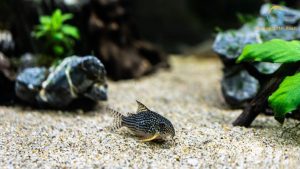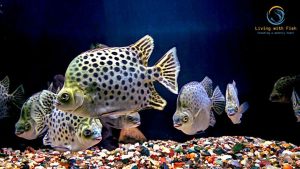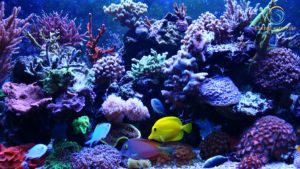This article covers the following areas –
- Why Fish Matter in Aquaponics
- Key Factors in Choosing Fish
- Top Fish for Your Aquaponics Adventure
- Tips for A Flourishing Aquaponics System
- Wrapping Up

If you’ve ever tried balancing on one foot with your eyes closed, you’ll get the challenge of maintaining an aquaponics system. I’ve been there! But just like you’d choose the right shoes for balance, picking the right fish can set your aquaponics journey on a steady course. I’ve handpicked some fantastic fishy candidates that are beneficial for your system and absolute joys to watch. Let’s dive in!
In aquaponics, ideal fish species efficiently convert feed into growth and produce waste beneficial for plant growth. Top choices include Tilapia, Goldfish, Trout, Catfish, and Koi. Each species offers unique benefits suited to different system conditions and regional climates.
Delve deeper into our comprehensive guide to better understand each fish species’ characteristics, requirements, and advantages in an aquaponics system. Discover how their individual traits can complement your setup, ensuring a thriving, sustainable environment.
Why Fish Matter in Aquaponics
Imagine an orchestra. You have the violins, the cellos, the drums, each instrument playing its part. In the realm of aquaponics, fish are like the lead singers, capturing the limelight and driving the melody. They’re not just there for the aesthetic appeal; they play a pivotal role. Dive into the world of aquaponics, and you’ll see how fish are so much more than glistening scales and rhythmic tails. They’re hardworking bioengineers aiding our plants in more ways than we often realize.
The Life-Giving Waste Cycle
Okay, let’s break this down. Fish eat. Fish produce waste. Sounds simple, right? But here’s where it gets fascinating. This waste doesn’t just sink and settle; it’s gold for our plants. When the waste breaks down, it releases ammonia. Beneficial bacteria in the system convert this ammonia into nitrites and nitrates. And guess what? Nitrates are plant food. It’s nature’s version of recycling!
Oxygen – A Two-Way Street
The aquaponics system isn’t just about water. It’s about oxygen too. While plants release oxygen during the day, which benefits our finned friends, fish respire, absorbing oxygen and releasing carbon dioxide. This CO2 then becomes a bonus for plants during photosynthesis. It’s like the most harmonious roommate setup ever!
Temperature Moderators
Have you ever noticed how a water body doesn’t heat up or cool as quickly as its surroundings? That’s because water has a high specific heat capacity. Cold-blooded fish play a role in stabilizing the water temperature in an aquaponics system, ensuring it doesn’t fluctuate drastically. This stability aids in the well-being of both fish and plants.
Pest Controllers
One of my favorite things about having fish in an aquaponics system is how they naturally control pests. Many fish, especially the smaller varieties, snack on larval forms of mosquitoes and other bugs. So, while they’re busy munching away, you get the added benefit of a reduced pest population.
Natural Tillers
Fish are the unsung heroes of soil aeration in an aquaponics system. They move, they dig, and in doing so, they keep the water circulating. This movement is like mini whirlwinds, ensuring the roots get all the nutrients evenly. Think of them as natural tillers, only underwater and way cuter.
In the end, fish in an aquaponics system are like the engine in a car. While you might appreciate the sleek design and the comfy seats, the engine keeps it running. Similarly, fish are the driving force, ensuring our plants get everything they need while adding a touch of beauty and serenity to the system.
Key Factors in Choosing Fish
Diving into aquaponics can feel like being a kid in a candy store. So many fish, so little time! But, before you get carried away with the allure of vibrant colors and mesmerizing patterns, there are some practical aspects you’ve got to nail down.
Think of it as matchmaking for your aquaponics system. You don’t just want any fish; you want the right fish. To ensure your system hums along harmoniously and the fish lead a happy, healthy life, let’s delve into some fundamental factors that should influence your choice.
The Temperature Tango
Fish are pretty fussy when it comes to their comfort zone. Some enjoy basking in warmer waters, while others prefer chilly things. It’s essential to choose fish that suit the average temperature of your region unless you fancy spending extra on heating or cooling equipment.
For example:
- If you’re in a region with long, cold winters, goldfish might be a great fit, as they can handle lower temperatures.
- In contrast, tilapia love warmer waters and would thrive in sunnier climates.
Growing Up Fast or Slow?
Whether you’re into aquaponics for the joy of it or eyeing those fish fillets, the growth rate can be a game-changer. Some fish sprout up quickly, ideal for those eager to harvest, while others take their sweet time.
Case in point:
- Catfish are fast growers, making them a top choice if you’re keen on a quicker harvest.
- On the other hand, koi, while stunningly beautiful, are more of a long-term commitment.
Munching Habits
Let’s talk grub. Different fish have different dietary quirks. While some are easy-going, munching on standard fish pellets, others might crave more specific foods, affecting the system’s balance.
For instance:
- Carp are omnivores, happily feasting on plants, insects, and smaller fish.
- Rainbow trout are carnivorous and would require a diet rich in proteins.
Peacekeepers or Troublemakers?
Here’s the tea: not all fish play nice. Some are like the zen yogis of the underwater world, while others… well, they have a bit of an attitude. You want to make sure the fish you introduce can coexist peacefully.
A couple of things to consider:
- Betta fish, though dazzling, can be territorial and might not appreciate tank mates.
- Conversely, guppies are generally peaceful and can mingle well with others.
Space and Size – Room to Roam
Just like we humans enjoy a bit of elbow room, fish, too, appreciate their space. Before deciding, consider how big your fish will get and if your tank offers them the space to swim and explore.
Here’s the scoop:
- Despite their beauty, Sunfish can grow pretty large and need ample space.
- Minnows, being smaller, are more forgiving regarding space constraints.
Choosing the right fish isn’t just about aesthetics but compatibility, comfort, and ensuring a harmonious ecosystem. Get these factors right, and you’re on your way to creating a thriving aquaponics sanctuary!
Top Fish for Your Aquaponics Adventure

So, you’ve decided to embark on the aquaponics journey – congrats! But now comes the fun (and slightly daunting) part: picking your aquatic companions. As you’d choose a roommate, selecting the right fish for your system is crucial. Not just any fish will do; you want a species that benefits the plants and is happy in your setup. But fret not, fellow aquaponics enthusiast! I’ve got you covered. Let’s dive into some top-notch fishy candidates, each bringing its own flair to the aquaponic dance floor.
1. Tilapia
Ah, Tilapia, the unsung hero of many aquaponics setups. They’re kind of like the jeans in your wardrobe – reliable, versatile, and fit well in most scenarios. Picture this: a chill, not too fussy fish, and, if you’re into it, makes a fantastic dinner. That’s our friend, Tilapia.
The beauty of Tilapia lies in its adaptability. They don’t throw tantrums if things aren’t just perfect. Slight changes in the pH or water clarity? They’ll generally take it in stride. But this doesn’t mean they appreciate being neglected. Like any living being, they flourish best under optimal conditions.
Speaking of growth, if you hope to see quick results, Tilapia won’t disappoint. Their speedy growth rate is a boon, especially if you’re aiming for a dual benefit – a healthy plant system and a potential source of protein. However, do keep an eye on their numbers. Their rapid growth means they can outgrow their space if not monitored.
Now, let’s chat about their diet. They’re not overly picky eaters, which, believe me, can be a huge relief. A good quality pellet feed usually does the trick. But occasionally treating them to some fresh greens or tiny aquatic critters? They’ll love you for it!
2. Goldfish
Goldfish might be the first fish many of us ever cared for. Those shimmering, darting little creatures are often a child’s introduction to the aquatic world. But don’t let their commonplace nature fool you; in an aquaponics system, they’re like the unsung workers backstage, ensuring the show runs smoothly.
One of the standout qualities of goldfish is their hardiness. These guys are survivors. Whether you’re a seasoned aquaponics enthusiast or just dipping your toes in the water (pun intended), goldfish are a forgiving choice. They’re not very demanding about their environment. They’re good to go as long as it’s clean and free from toxins.
But here’s where they shine – waste production. These little swimmers are prolific waste producers. This waste is nothing short of liquid gold for plants in an aquaponic system. It’s rich in nutrients and helps plants thrive. It’s a beautiful cycle – the goldfish support the plants, and the plants, in turn, help purify the water for the fish.
However, there’s one thing to remember. While they might benefit the system and please the eye, goldfish are best kept as pets. They have been companions to humans for centuries, brightening up spaces with their golden hues. So, while they work hard for your plants, let’s treat them with the love and respect they deserve. No dinner plates for these beauties!
3. Trout
When it comes to trout, think of them as your system’s cold-loving, slightly finicky fishy residents. Native to colder climates, they’ve acclimated themselves to thrive in chillier waters, making them a prime choice for folks living in areas where snowflakes are a common sight. But their love for the cold doesn’t make them any less exciting. Their sleek bodies, often adorned with unique patterns, make for a visually stunning display.
But there’s more to trouts than just their looks. For culinary enthusiasts, trout are like the hidden gem in an aquaponic setup. They can grow to a decent size with the right care and conditions, providing a fresh, delicious meal. Just imagine going from tank to table in a matter of hours! Freshness guaranteed.
However, and this is important, trout have a bit of a reputation for being picky about their environment. Cleanliness is next to godliness for them. They thrive in pristine water rich in oxygen. They’re like that guest who notices the dust under your rug; nothing escapes their notice. So, if you opt for trouts, be ready to invest some time in ensuring the water conditions are just right. Regular checks, a robust filtration system, and perhaps an added aeration device will keep them content and thriving.
4. Catfish
Enter the catfish world, and you’re in for an exciting journey. These guys are like the rockstars of freshwater fish. Their unique appearance, characterized by their signature ‘whiskers’ or barbels, makes them instantly recognizable. But don’t be fooled by their rugged looks; they’re pretty laid-back at heart.
One of the joys of introducing catfish to your aquaponic system is their adaptability. Whether you’re a seasoned aquaponic gardener or just starting, catfish can ease your journey. They don’t throw a fuss if the pH level fluctuates or the water isn’t crystal clear. This flexibility can be a blessing, especially when you’re still figuring things out.
But let’s talk about their habitat. While they might be forgiving about water conditions, they do have a soft spot, quite literally. Their underbellies are sensitive. So, if you’re thinking of making them permanent residents, consider their comfort. A soft substrate, like fine sand or smooth gravel, will keep them happy. Imagine it as offering a comfy carpet for them to lounge on.
Lastly, while they’re not overly aggressive, remember that larger catfish might snack on smaller tank mates. So, if you’re planning a community setup, ensure everyone gets along. After all, harmony is the key to a thriving aquaponic system!
5. Koi
Koi are synonymous with elegance and grandeur. When you think of elaborate garden ponds with exquisite fish gliding gracefully, chances are, you’re envisioning koi. Originating from Japan, they’re often associated with positive imagery – symbols of love, friendship, and perseverance. Their intricate patterns and varying colors, ranging from vibrant oranges and reds to calm whites and blacks, are often the topic of admiration.
One of the first things that catch most newcomers off-guard is the sheer size these beauties can achieve. In ideal conditions, some koi can grow to lengths that can rival your average domestic cat. This means if you’re considering them for your aquaponics system, ensure you have ample space. They’re not just about the show; they love their wiggle room.
While their elegance might suggest they’re high-maintenance, you’d be pleasantly surprised. Koi are pretty hardy. They adapt well to varying conditions and once settled, they can endure a range of water temperatures and qualities. However, this doesn’t mean they should be neglected. Regular checks, clean water, and a balanced diet will ensure they keep painting your waters with their vibrant colors.
Speaking of diet, here’s where things get interesting. Koi have a hearty appetite, which means they produce a generous amount of waste. And in the aquaponics world, that translates to nutrient-rich food for your plants. It’s like having a natural fertilizer factory right in your backyard.
However, with their majestic presence comes responsibility. Koi can live for many years, some even hitting the century mark! So, if you’re bringing them into your world, it’s a long-term commitment. And given their spellbinding beauty, they’re often seen as pets rather than food. Treating them with care, respect, and admiration is the way to go. After all, they’re not just fish; they’re living art.
Choosing the perfect fish for your aquaponics setup combines science and personal preference. Whether you’re leaning towards the taste of tilapia or the tranquil beauty of koi, ensure they have a conducive environment. Remember, a happy fish means a thriving aquaponics system!
Tips for A Flourishing Aquaponics System

Suppose you’ve set up your aquaponics system, chosen the fish, planted the greens, and everything’s humming along beautifully. But remember, it’s not just “set and forget.” Think of it like a budding relationship – it needs care, understanding, and a wee bit of pampering. Before you feel overwhelmed, I’ve got you covered with some handy tips to ensure your aquatic garden thrives like a champ.
Monitoring is Key
Think of your aquaponics system as a mini-ecosystem. And just like any ecosystem, some factors can throw things out of whack. I can’t stress this enough: monitor, monitor, and then monitor some more. Keeping a regular check on:
- pH levels: Aim for a neutral range. Too high or too low can stress your fish and hinder plant growth.
- Ammonia: A buildup can be harmful. If you see it rising, it might be a sign you’ve got too many fish or they’re overfed.
- Nitrites: Keep these low. High levels can be toxic to your fish.
By having a routine check, you can quickly catch potential problems and make necessary adjustments. Plus, seeing those numbers stabilize over time? Oh, the satisfaction!
Don’t Overcrowd
I get it. Fish are enchanting, and adding just one more to the mix is so tempting. But here’s the deal: more fish means more waste and oxygen consumption. Overcrowding can lead to:
- Oxygen shortages cause stress to your fish.
- Elevated waste levels can disrupt the balance of your system.
A golden rule? Less is more. Aim for a balance, ensuring each fishy friend has enough space to roam and thrive. And remember, as they grow, they’ll need more room!
Feed Them Right
Food is more than just fish fuel. What goes into the fish eventually goes to the plants. So, think of high-quality fish food as a two-for-one deal – it keeps your fish healthy and ensures that the waste they produce is chock-full of nutrients for your plants. A few pointers:
- Opt for organic or non-GMO feeds when possible.
- Be wary of overfeeding. Too much uneaten food can decay and mess with your water quality.
- Observe your fish. They’ll tell you if they’re hungry. If they leave food behind, you’re probably giving them too much.
Your aquaponics system is a harmonious dance between fish and flora. Monitoring the environment, giving fish their space, and ensuring they’re well-fed pave the way for a thriving, self-sustaining ecosystem. So, roll up those sleeves and nurture the balance – trust me, it’s worth it!
Wrapping Up
Aquaponics is a beautiful blend of aquaculture and hydroponics, where fish and plants coexist in a symbiotic environment. The choice of fish plays a pivotal role in the system’s success. Whether it’s the fast-growing Tilapia, the resilient Goldfish, the cool-loving Trout, the easy-going Catfish, or the majestic Koi, each fish offers unique advantages.
You can create a harmonious aquaponics setup by understanding their requirements and aligning them with your system and climate. Embrace this sustainable approach to farming, where fish and plants flourish together, contributing to a greener and healthier future.






